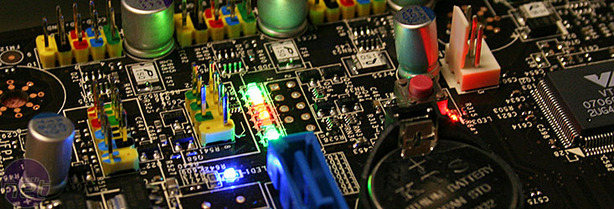PCB & PCI-Express
MSI uses the standard good looking black PCB that most people seem to prefer, with every port and connector coloured with a subtle differentiation for ease of use without looking like a "My First Motherboard". The white ports are PCI-Express x16 and x1 and also PCI, with the different lengths providing differentiation. The second PCI-Express x16 slot is in yellow to denote it's bandwidth is only x4. As a result of using CrossFire, you can only use one PCI slot if your graphics cards use dual slot coolers.Due to the way the six PCI-Express connections on the southbridge are distributed, both the Gigabit Ethernet and Marvell IDE/SATA have a dedicated use. This means that both PCI-Express x1 slots are disabled when using CrossFire because it sucks up the use of four of the six PCI-Express connections.
The entire motherboard uses solid state aluminium capped capacitors, rather than the older electrolytic type, which provides a better power delivery and a longer lifetime.
SATA
The SATA ports also have a differentiation between native purple SATA and single blue Marvell SATA. Both support the SATA 3Gbps specification - the purple ports are connected to the ICH9R southbridge, whereas the blue port connected to the Marvell controller is fed through a PCI-Express x1 connection. The last two SATA ports from the ICH9R southbridge are used as eSATA ports instead, this means that you only get five internal ports compared to most P35 boards' six. Unlike the Gigabyte GA-P35-DS3R board, there's no option of eSATA use, it's a permanent addition whether you need it or not.Due to the arrangement of the fifth, blue SATA port, using CrossFire with a long card means this port is unavailable, so you're only left with four internal SATA ports.


Memory
Memory slots are coloured according to channel, but memory sticks still need to be plugged in alternate slots for dual channel operation. This is in contrast to most boards where DIMMs are plugged in same coloured slots. They are placed just high enough not to interfere with a long graphics card but popping ram in and out is slightly fiddly.Heatpipes
We're pretty used to seeing heatpipes distributing heat now, but MSI makes its own version with two circular additions over the northbridge to provide more surface area and better heat dissipation. The large array encloses the CPU socket, and the one between memory and CPU doesn't actually cool anything in particular, it's simply there to provide a greater surface area. It is very close to memory slots but even the wider than usual OCZ FlexXLC still fit just fine.The Circu-Pipe metal label on top of the fins does limit the natural radiation of heat upwards from the fins, although we can't argue with an all fanless cooling solution on the whole.
Post readout
The D-LEDs are now integrated into the motherboard, rather than taking up a USB port and being lumped at the rear of a case. They are both very useful and colourful, where if you basically get red then something has gone bad. The manual can be used to decode the light array and it's certainly smaller than a two character LED readout, but the readout is still far easier to use as it's codes are constant across motherboards.
Power sockets, connectivity and pin outs
The ATX socket and other pin outs are well placed, except for the additional molex socket and 8-pin 12V power cable, which requires a power cable dragged across the face of the board. The 8-pin is placed in between heatpipes but MSI includes an elevated adapter to make it far easier to use. Without the adapter (make sure your board has one!) it's almost impossible to get the plug out - we had this problem with the first P35 Platinum we got.Even though the IDE port is 90 degrees to the board to minimise cable mess, the cable naturally propagates 90 degrees to the plug anyway, so effectively you're pushing it into the PCB. Even though it's a nice idea, it's more important to put the SATA ports at 90 degrees to the motherboard or to include 90 degree cables in the box.
The Firewire pin out is in green (one port) and the USB pin outs (six ports) are yellow, with specific colours according to what each pin does. This is extremely useful if your plug doesn't come in the normal 5x2-pin block, however the front panel pin out is coloured almost exactly the same and lies in the same area to the USB pin outs which makes it all quite confusing.
The S/PDIF out pins are also placed close by, along the bottom of the PCB, but they are surrounded by a keyed plastic shroud. Finally, both the front panel audio and COM ports are black, and are awkwardly differentiated between by small labelling on the PCB itself. No cables for any of these are provided in the box, however.
Sound
Realtek provides the sound codec from the ALC888 chipset, which offers 7.1 channel HD audio with up to 192KHz/32-bit support. The series supports two stereo ADCs (analogue to digital converters) that can support a stereo microphone featuring Acoustic Echo Cancellation (AEC), Beam Forming (BF), and Noise Suppression (NS) technology. The DACs (digital to analogue) are rated at 97dB and ADCs are rated at 90dB, with both being analogue weighted. Solid state aluminium capped capacitors are used for the sound codec as well, to increase the potential fidelity through better power delivery.Ethernet
The board has a single PCI-Express Realtek RTL8111B Gigabit Ethernet port which should be good enough for most people, but this is still limited compared to what other boards offer. Ideally we'd have at least one Gigabit Ethernet and WiFi, since it's what most people use.
MSI MPG Velox 100R Chassis Review
October 14 2021 | 15:04









Want to comment? Please log in.